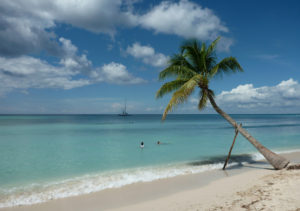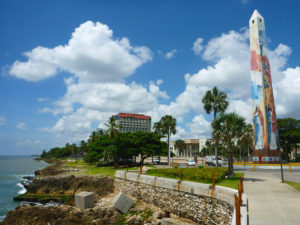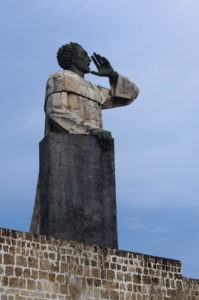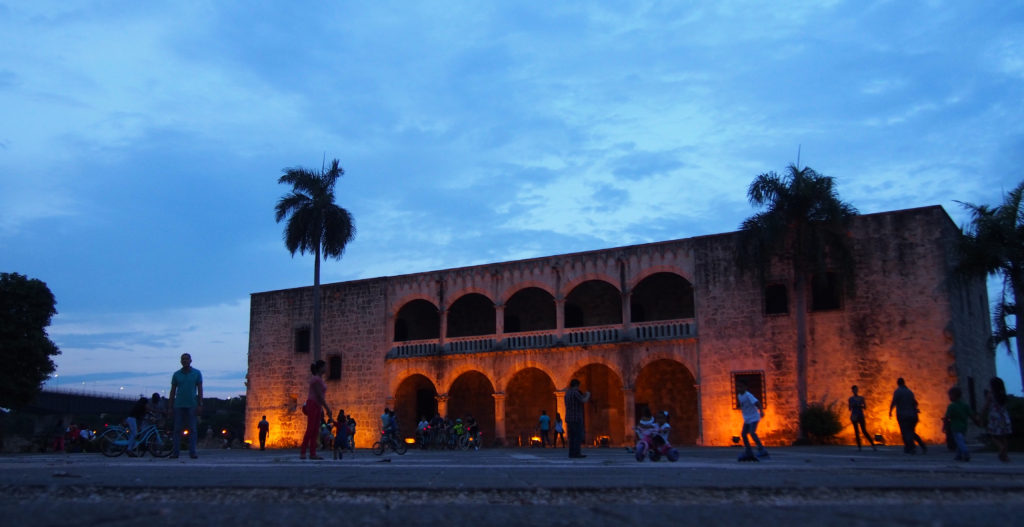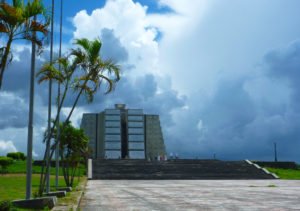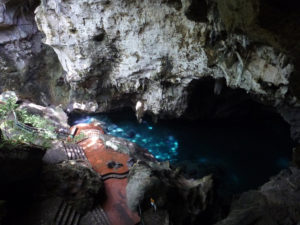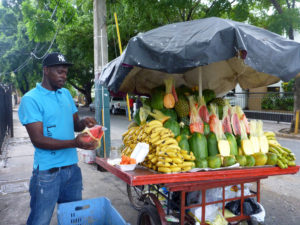When I arrived in the Dominican Republic everyone I met was so positive about the country, they all said I’d fall in love with the place and never want to leave.
After being there for a short time the cynic in me believes that people only stay because they are paid so poorly in an expensive country and they simply can’t afford the flight out. Moving to Santo Domingo was possibly one of the most uninformed, unexplained, and therefore became one of the worst, decisions of my life.
The negatives…
Work conditions and false promises
I got my job in the Dominican Republic through an online advertisement for a language academy, Academia Europea in Santo Domingo. The company presents as professional, and I was quite excited by the prospect of teaching English internationally.
Prior to accepting and arriving I asked some questions regarding work visas, pay rates, amount of hours of employment, how that balances against cost of living, how to find accommodation and so on.
Work Visa
So I was told that no work visa was required, but once I was on contract it could be negotiated. I should enter on a tourist card and renew it every two months (I found out later it only has a 30 day validity, not 60).
I then discovered the company had no intention of providing a work visa, it was something I could do and pay for if I wanted to, rather I was told to simply overstay my tourist card and pay the ‘cheap’ fine on exit. The cheap fine is no longer cheap, it is 2500 pesos, which is a week’s wages for me. I was told that everyone works in this way on an overstayed tourist card, and while that may be the case it is not actually legal, and is something I am uncomfortable with.
Pay Rates
 The hourly rate of training is 180 pesos, when you pass the proficiency exam the rate goes up to 200 and some time later if you are recognised as a good teacher (I don’t know how this is assessed) it goes up to the highest pay rate of 250 pesos per hour. 200 pesos compares to €3.87 or $4.30US or $5.62AUD on today’s exchange rates, which was my pay rate for the duration of my stay and teaching.
The hourly rate of training is 180 pesos, when you pass the proficiency exam the rate goes up to 200 and some time later if you are recognised as a good teacher (I don’t know how this is assessed) it goes up to the highest pay rate of 250 pesos per hour. 200 pesos compares to €3.87 or $4.30US or $5.62AUD on today’s exchange rates, which was my pay rate for the duration of my stay and teaching.
Once I began the two week training program I double checked on the pay rates, only to be told the three hours per day, five days per week of training is unpaid. The training wage is for the classes you teach after you have completed training but before completing the proficiency exam. As an experienced teacher I was upgraded to the proficient payment level immediately when I began classroom teaching.
Oh, and there’s certainly no paid preparation or marking time, you are only paid for in class teaching time.
Hours of Employment
The academy is open seven days a week, thirteen hours a day. I was told I could make as much money as I wanted based on how many hours I wanted to work.
 As I wanted to gain as much experience as possible, and with a need for an income I set my availability to be any time, any day over the full opening hours of the academy. I was open to teach any level any time.
As I wanted to gain as much experience as possible, and with a need for an income I set my availability to be any time, any day over the full opening hours of the academy. I was open to teach any level any time.
The hours I was given were 8-9am Monday to Friday, 6-8pm Monday to Thursday and 1:30 – 4:30pm on Saturdays but when on one occasion indicated I could not make it to my Saturday class, the class was promptly and permanently reassigned to another teacher.
I averaged 2.6 hours per day, six days per week (originally 16 hours per week, which dropped to 13 hours).
A week of teaching my own classes would earn 3200 pesos (or 2600 after my Saturday class was reassigned).
A good week of teaching my own classes and relief teaching for others could earn as much as 4200 pesos.
Cost of living based on local wages
When you earn a local wage, the cost of living in Santo Domingo becomes unaffordable. If you are comfortable to rent an apartment in an unsafe ‘barrio’ then you could possibly make ends meet, but living in a safe suburb I could not.
Despite promises of assistance to find housing, none was provided. In the case of a non-Spanish speaker this poses a huge challenge!
Things that cost approximately the same as my hourly wage:
- a box of cereal
- a bottle of shampoo
- a 6″ “sub of the day” sandwich at Subway
- a coffee in a cafe
- a small beer at a bar
Monthly Living Expenses
Rent 10,000 pesos
Utilities (Internet, power and water) 1050 pesos
Cell Phone 400 pesos
Drinking Water 140 pesos (tap water in the DR is toxic, all water for drinking and cooking must be purchased)
TOTAL: 11,590 pesos
Monthly Work Expenses
Grammar Textbook 1920 pesos (I chose not to buy the book but the price indicates what is required in the job. This will not be used in any further calculations)
Whiteboard Markers, Whiteboard Eraser, Pens, Pencils and Paper 700 pesos
Transport 100 pesos – 210 pesos daily dependent on how many locations I worked at in any given day. For the calculations I will average at 150 pesos per day. Total of general required expenses is 3600 pesos
TOTAL: 4300 pesos
Not including food or any other basic living expenses, my monthly expenses equated to 15,890 pesos.
After being taxed on my income, I earned 10,440 pesos
My monthly loss, before eating/general basic necessities was 5,450 pesos!
The Academy’s Profits
A daily class is one hour per day, five days per week for four weeks. I was paid 200 pesos per hour, which equates to 4000 pesos per 4 weeks for that class.
A student enrolled in my daily class pays 3,990 pesos per 4 weeks.
A class needs a minimum of 5 students to run, 19,950 pesos per 4 weeks. My typical classes had at least 8 students per class, 31,920 pesos. A daily class of 8 students results in a school profit of 27,920 pesos (less academy running expenses). The director is aiming to increase class sizes to at least 10, where in my classroom we could barely fit eight into the tiny room, when the staff are so poorly paid it makes me wonder where this money goes? And whether the primary focus is education or profit?
Objectification of Women
This is something I already mentioned in my first post about Living in Santo Domingo, many Dominican men in general have what I consider to be an antiquated view of women and their place in society. It is simply unfathomable that a woman would want to be on her own, and as such they all ask about your boyfriend or husband; if you have neither it must mean you want their phone number. As much as I hate doing so, I resorted to lying about my marital status and I wore a fake wedding ring.
One time I had a man tell me he had been checking out my legs and then said “Mmmmmm like Bacon” genuinely left me feeling furious, but not in fear of my safety.
When you aren’t in close enough proximity to actually have a conversation, then it is common to be hissed at, whistled at and called out to. I’m not sure if it was a blessing or curse that I didn’t understand much of what they called out at me, but I never felt particularly threatened by any of it, though it made me feel uncomfortable and annoyed.
Safety
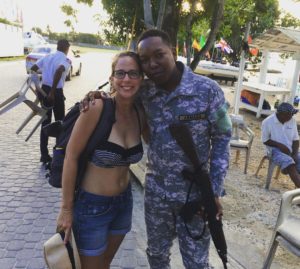 Having come from Australia, a safe country, our perception of danger is certainly on a different level to those who experience it regularly in their lives.
Having come from Australia, a safe country, our perception of danger is certainly on a different level to those who experience it regularly in their lives.
The travel advice from the Australian Government lists travel to the Dominican Republic as a yellow alert: Exercise a high degree of Caution. I have been to yellow alert countries in the past, and being street smart have never had any issues or felt particularly at risk.
On the ground in Santo Domingo, everyone was telling me how common muggings are, almost everyone has been mugged, typically at gunpoint at least once, but often a few times. So fear kicks in with any normal person at this point, myself no exception. In discussion with people, I found their opinions conflicting. While it’s dangerous and terrifying, it’s going to happen, but it’s fine, it’s normal, nothing to worry about.
In a conversation with a friend in the space of ten minutes, she told me:
- she was saddened that I felt unsafe in her country
- it is quite a safe country, not as bad as people imply
- she wouldn’t walk anywhere as the streets are unsafe
- her sister was mugged twice at gunpoint in the space of two weeks
- a friend of her was stabbed to death in his home
- but Santo Domingo is a safe place to be
The company I worked for has three locations, and I have worked at all three. In my second week of working I got two notices that really freaked me out.
Firstly, I was told that at one of the locations there had been a bank robbery and shoot out resulting in a death and several people were injured.
Secondly, the other location I was working at every night had reports of a thief who was posing to help people with public transport, but would hold them up as his partner came on a motorbike to mug them.
Walking home from the metro station at night in the dark also freaked me out, but I couldn’t afford an Uber every day, so I just tried to be wary, listen, look around, walk quickly and hope for the best. On one occasion, I returned home just five minutes after a housemate, who had seen a girl mugged on our street just moments earlier. Since then I texted him when I caught the metro so he could walk me home every evening.
Numerous colleagues have been mugged exiting the bank just after cashing their pay cheque. When you work hard all month, for the pittance you receive and require in order to eat, the worst thing is to lose it all.
So honestly, being constantly afraid of being mugged is not a nice way to live your life!
My bus story..
My last few days in the Dominican Republic were spent sightseeing; on my final bus trip from Las Terrenas back to Santo Domingo a friendly Dominican man sat next to me with his baby. He was determined to have a conversation with me, which was all translated via a friend sitting across the aisle.
The man was returning to Santo Domingo to turn himself in to police. In a ‘crime of passion’ he had shot his wife and her lover, I think in the legs, and kidnapped his five month old baby. Evidently after some time on the run he was returning to Santo Domingo to be locked in jail and face three criminal charges (my guess is that he was giving himself to police because perhaps that was safer than being on the streets after having shot another man). As he shifted uncomfortably in his seat I did worry that he may have had a gun tucked into the waist of his pants, thankfully I did not find out either way.
Taking the positives..
As with any decision, good or bad, your attitude affects your experience. I certainly tried my hardest to make the most out of this bad experience.
When time and money allowed I went on excursions to see as much of the island’s natural beauty as I could. I knew that hiding beyond the city limits were amazing things to see, and as you would have read I made visits to beautiful beach areas of Punta Cana, Bahia de Las Aguilas, Puerto Plata, Isla Saona and Las Terrenas.
In addition to seeing the country itself, I met some absolutely amazing people. Some of my colleagues, students and random people I met along the way are genuinely beautiful, honest and trustworthy people who I hope to remain in contact with for years to come.

